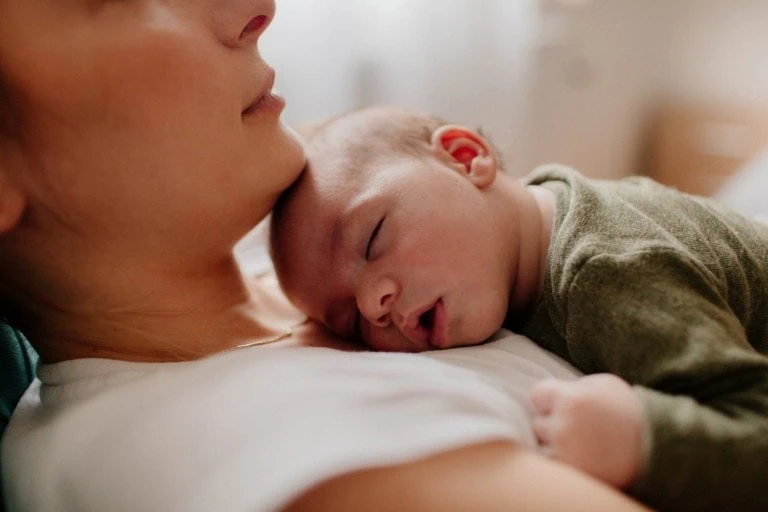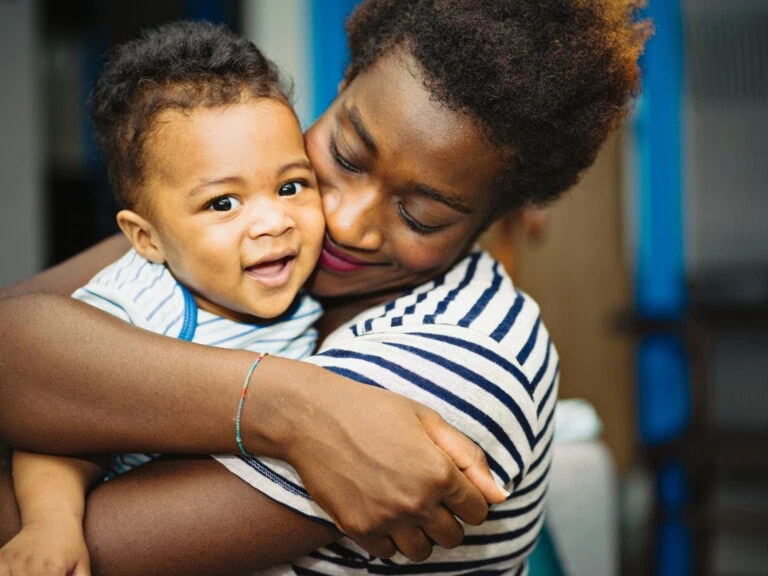Attachment is the unique relationship or bond between you and your baby. The quality of this bond can vary, but a secure attachment bond or style with your baby is all about the wordless, emotional exchanges between the two of you that help your baby feel safe and calm.1 Attachment is a critical factor that underpins how your little one develops socially, emotionally, and even physically.
What Is Secure Attachment?
Does your baby cry when you leave them? Do they quickly recover when you return? They are likely experiencing secure attachment. So, what does that mean? The definition of secure attachment in psychology (developed initially and explored by Mary Ainsworth and John Bowlby) explains how a primary caregiver’s sensitivity and responsiveness to their child’s needs create a sense of trust, resilience, and confidence. Attachment theories suggest that when caregivers are aware of and responsive to their child’s needs, the child develops a sense of security. They also learn that they can depend on their caregiver, which creates a secure base that allows them to explore the world around them.1
This original theory stems from four main types of attachment.1 While a secure attachment style indicates that your baby feels safe and secure knowing they can depend on you, the other three styles signal an insecure attachment bond. An insecure attachment style can hinder your child’s brain development, impact their mental, emotional, and physical development, and negatively affect their ability to form relationships as they grow.2 This arises when caregivers fail to meet their children’s needs, which can happen for various reasons. The three additional attachment styles are:3
1. Ambivalent Attachment
Children who are ambivalently attached can be quite suspicious of strangers and experience intense distress when separated from their primary caregiver. However, their caregiver often does not comfort or reassure them when they return and may reject or be aggressive toward them.
2. Avoidant Attachment
Children who are avoidantly attached typically avoid their caregivers. This might be more noticeable after a period of absence. While they might not outwardly reject their parents’ attention or presence, they don’t actively seek out contact with them or comfort from them. They typically don’t know any preference between their caregiver and a stranger.
3. Disorganized Attachment
Children who experience a disorganized attachment pattern with their parents don’t typically show clear attachment behaviors. They respond to their caregiver in a mixed way; they might be avoidant or ambivalent. They may even seem apprehensive or confused by the presence of their caregiver.
Why Is Secure Attachment So Important?
Developing a secure attachment style with your baby is essential. When you meet their needs for security and safety, it means their nervous system is optimally developed. Secure attachment in infants allows their developing brain to “organize” itself on a foundation of safety.4 I know that sounds a little confusing, but your child’s brain develops and starts to make sense of the world by using early experiences to guide it. So, if your child experiences a strong, secure early relationship, they will usually feel safe, have the energy to explore the world around them, and assume they can trust other people.
Your baby or child who experiences a secure attachment style tends to encounter the following benefits:4
- Have a healthy sense of self-awareness
- Better equipped to identify their needs, share their feelings, and ask for help or support to get their needs met
- Increased empathy
- Increased feelings of trust (ability to trust others)
- Be more eager, willing, and able to learn (which can increase achievement in school)
- More independent and willing to explore or try new things
- Be more resilient or react better to stressful events
- Have better problem-solving skills
- Experience stronger, more positive relationships
- Have better self-esteem
- Be less likely to experience depression or anxiety
Tips for Creating a Secure Attachment With Your Baby
Considering the massive benefits, it’s essential to understand how to develop a secure attachment style with your little one. Here are some tips for secure attachment parenting:
1. Eat, Sleep, Repeat
This one is a quick win. You will be getting into feeding and sleep routines, and because a secure attachment style with your baby means you are responding to (and are aware of) their needs, this daily activity is already setting you down a good path. As you get to know them, you will start being able to read their cues — “Aha, that’s a cranky, tired cry” versus “That’s their hungry cry.” These form the building blocks of secure attachment, as you will start to follow their cues and respond to their needs.5
2. Become a Detective
This one comes with time as you get to know your baby. Their cries might sound similar, but they will show you what they need. You don’t need to get it right 100% of the time, but it’s vital that you pay attention to their facial expressions, postures, etc., try to figure out what they mean, and then respond. Every baby is different, as is their preferred way of being comforted — jiggle them up and down, go somewhere quiet and calm, hold them close and have a cuddle, etc.
You could have a mental checklist of all the possible baby needs and check them off until you get it right. Then, learn from it and try to remember for next time. Remember, babies can cry for complex, inscrutable baby reasons, so sometimes it is about time, patience, and contact with you before they do settle.
3. Look After Yourself
Being stressed, overwhelmed, burned out, etc., makes it harder to be present and engaged with your little one. I know it’s easier said than done when your whole life has been tipped upside down by your new arrival. You might be sleep-deprived, and your relationship with your partner, among other things, could change. But try to ask for help or accept it when it’s offered. Ensure that when you have a chance, you engage in self-care. You could pop the baby in the carrier and do some postpartum safe yoga (once you have had your approval from your postpartum check-up). You could pop in your headphones and listen to an audiobook while you are feeding bub or nap trapped. Just try to sneak in ways to look after yourself.
4. Manage Your Own Emotions
Yes, you will be a big bundle of hormones postpartum, and sometimes, those sleepless nights will make you a bit cranky. However, it’s important to manage your feelings, as our little ones can pick up on our stress and anxiety.5 As they feed into your feelings, they will be harder to soothe, exacerbating your stress. It can become a bit of a vicious cycle.
So, find ways to calm down or self-soothe before interacting with your little one. This could be taking a few calm breaths before grabbing them from their crib. Or you could practice progressive muscle relaxation while feeding them or before you get out of bed in the morning. Maybe you could get a stress ball, use calming scent roller balls, get a massage from your partner, or find other nice sensory activities to help you feel calm.
5. Have Fun With Your Baby
It’s essential to make eye contact, laugh, smile, and enjoy your time with your baby. They will pick up on your cues (i.e., that you enjoy being with them) and feel connected to you and comforted by your actions. You aren’t a robot, so don’t force a smile or expect to be 100% happy 100% of the time. But set some time aside each day to really get on their level and connect. Try to time it for when they aren’t tired or overstimulated; otherwise, it can make them more unsettled.
Challenges To Creating a Secure Attachment With Your Baby
There is no rulebook or one-size-fits-all approach to creating a strong and secure attachment by meeting your child’s needs. They are just as unique as we are, and so are their preferences. But other reasons or things happening in your world might affect your ability to create a secure attachment style with your baby. Challenges can come from either the side of the parent or baby. From the parent’s side, these barriers can include:6
- Sleep deprivation
- High levels of stress
- Lack of support
- Living in an unsafe environment (either their home or community)
- Depression, anxiety, or other emotional problems (These can impact or make attachment more challenging, but they don’t necessarily equate to insecure attachment. For instance, a parent with
- depression might find it harder to develop a secure bond, but it doesn’t necessarily mean that it won’t happen.)
- Adverse childhood experiences, including abuse, neglect, or a chaotic childhood
- Drug and alcohol problems
Babies with the following characteristics may have challenges with secure attachment:
- Some babies have temperaments that are fussier or harder to soothe
- Babies who had problems in utero or during delivery
- Babies who were born premature or had other reasons that led them to be in intensive care
- Those who have been separated from their primary caregiver at birth
- Health issues either at birth or from an early age
- Babies with many caregivers (inconsistent caregivers)
Remember, you don’t have to be a perfect parent to create a secure bond with your baby. All you need to do is try your best and persist. Secure attachment is about quality and your willingness to respond to your child’s needs, even if you don’t get it right 100% of the time. It can even help attachment become secure if you recognize that you haven’t met their need and correct it. This shows your intention to be aware of their needs and your willingness to meet them.
Parenting can be tricky; there is no manual, and it can be complicated and confusing. So, if you are struggling with attachment or bonding with your child, it’s essential to seek support early on so things can get back on track!













































